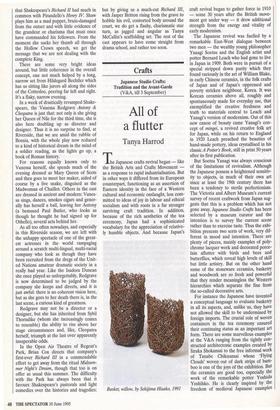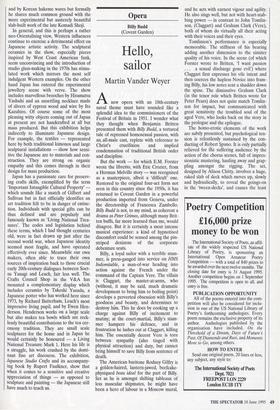Crafts
Japanese Studio Crafts: Tradition and the Avant-Garde (V&A, till 3 September)
All of a flutter
Tanya Harrod
The Japanese crafts revival began — like the British Arts and Crafts Movement — as a response to rapid industrialisation. But in other ways it differed from its European counterpart, functioning as an assertion of Eastern identity in the face of a Western cultural and economic onslaught, less com- mitted to ideas of joy in labour and ethical socialism and with roots in a far stronger surviving craft tradition. In addition, because of the rich aesthetics of the tea ceremony, Japan had a sophisticated vocabulary for the appreciation of relative- ly humble objects. And because Japan's Basket, willow, by Sekijima Hisako, 1991 craft revival began to gather force in 1910 — some 30 years after the British move- ment got under way — it drew additional strength from the energy and vitality of early modernism.
The Japanese revival was fuelled by a remarkable East-West dialogue between two men — the wealthy young philosopher Yanagi Soetsu and the English artist and potter Bernard Leach who had gone to live in Japan in 1909. Both were in pursuit of a special stripped down purity which they found variously in the art of William Blake, in early Chinese ceramics, in the folk crafts of Japan and of Japan's oppressed and poverty stricken neighbour, Korea. It was Korean ceramics above all, roughly and spontaneously made for everyday use, that exemplified the creative freshness and truth to materials central to Leach and Yanagi's version of modernism. Out of this new canon of beauty came Yanagi's con- cept of mingei, a revived creative folk art for Japan, while on his return to England in 1920 Leach preached the beauties of hand-made pottery, ideas crystallised in his classic A Potter's Book, still in print 50 years after its first publication.
But Soetsu Yanagi was always conscious of the limitations of revivalism. Although the Japanese possess a heightened sensitiv- ity to objects, in much of their own art since at least the 19th century there has been a tendency to sterile perfectionism. The Victoria and Albert Museum's current survey of recent craftwork from Japan sug- gests that this is a problem which has not gone away. Japanese Studio Crafts has been selected by a museum. curator and the intention is to survey the current scene rather than to exercise taste. Thus the exhi- bition presents two sorts of work, very dif- ferent in mood and intention. There are plenty of pieces, mainly examples of poly- chrome lacquer work and decorated porce- lain aflutter with birds and bees and butterflies, which reveal high levels of skill but little artistry. But on the other hand some of the stoneware ceramics, basketry and woodwork are so fresh and powerful that they render meaningless the Western hierarchies which separate the fine from the so-called decorative arts.
For instance the Japanese have invented a conceptual language to evaluate basketry in all its aspects, and, unlike us, they have not allowed the skill to be undermined by foreign imports. The crucial role of woven containers in the tea ceremony ensured their continuing status as an important art form. There are some marvellous examples at the V&A ranging from the tightly con- structed architectonic examples created by Iizuka Shokansai to the free informal work of Tanabe Chikuunsai whose 'Flying Clouds' woven- out of dark strips of bam- boo is one of the joys of the exhibition. But the ceramics are good too, especially the work of the remarkable potter Yoshida Yoshihko. He is clearly inspired by the freedom of medieval Japanese examples and by Korean hakeme wares but formally he shares much common ground with the more experimental but austerely beautiful slab-built work of the late Komadi Shoji.
In general, and this is perhaps a rather neo-Orientalising view, Western influences continue to exercise a detrimental effect on Japanese artistic activity. The sculptural ceramics in the show, especially pieces inspired by West Coast American funk, seem unconvincing and the introduction of studio glass-making in the 1970s has stimu- lated work which mirrors the most self indulgent Western examples. On the other hand Japan has entered the experimental jewellery scene with verve. The show includes marvellous brooches by Hiramatsu Yashuhi and an unsettling necklace made of slivers of cypress wood and wire by Ito ICazuhiro. Of course some of the most pleasing witty objects coming out of Japan at present are not handcrafted at all but mass produced. But this exhibition helps indirectly to illuminate Japanese design. For example, the textiles — represented here by both traditional kimonos and large sculptural installations — show how sensi- tive the Japanese are to materials and con- struction. They are strong on organic empathy and this comes through in their design for mass production.
Japan has a passionate care for preserv- ing crafts skills, exemplified by the term 'Important Intangible Cultural Property' — which sounds like a snatch of Gilbert and Sullivan but in fact officially identifies an art tradition felt to be in danger of extinc- tion. Individuals with special gifts can be thus defined and are popularly and famously known as 'Living National Trea- sures'. The codes and legislation behind these terms, which I had thought centuries old, were in fact drawn up just after the second world war, when Japanese identity seemed most fragile, and have operated effectively ever since. Meanwhile our own makers, often able to trace their own sources of inspiration back to those crucial early 20th-century dialogues between Soet- su Yanagi and Leach, fair less well. The. Crafts Council Shop in the V&A has mounted a complementary display which includes ceramics by Takeshi Yasuda, a Japanese potter who has worked here since 1973, by Richard Batterham, Leach's most impressive living pupil, and by Ewen Hen- derson. Henderson works on a large scale but also makes tea bowls which are reck- lessly beautiful contributions to the tea cer- emony tradition. They are small scale sculptures for the home and in Japan he would certainly be honoured — a Living National Treasure Mark 1. Here his life is a struggle, his work crushed by the domi- nant fine art discourse. The exhibition, Japanese Studio Crafts and its accompany- ing book by Rupert Faulkner, show that when it comes to a sensitive and creative appreciation of things — as opposed to sculpture and painting — the Japanese still have much to teach us.



































































 Previous page
Previous page